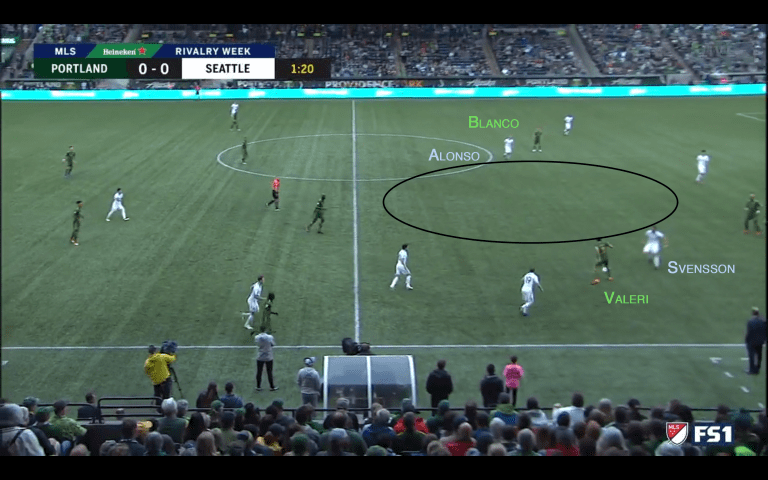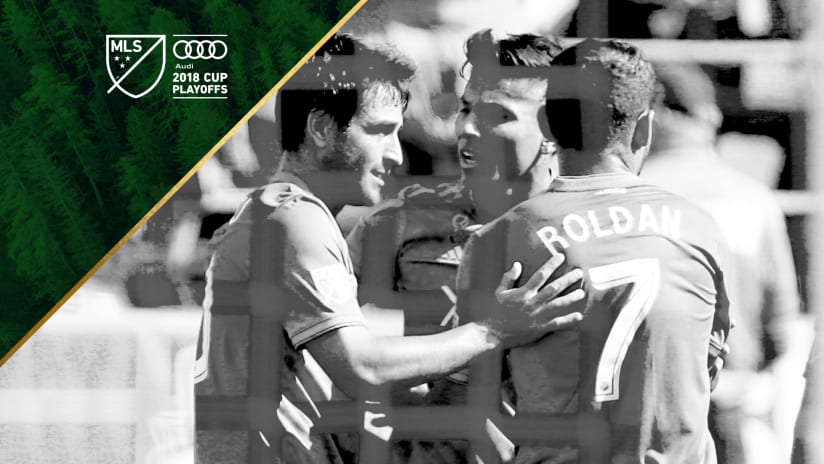It’s amazing how many similarities there are between the Portland Timbers and Seattle Sounders FC, when you start looking at the teams’ personnel. Perhaps amazing is too much, but between the teams’ mirror-image midfields, complements out wide, veterans in central defense and experience in goal, in some areas, the teams feel cut from the same cloth.
Fans won’t want to think of the similarities between the world’s Charas and Alonsos or Valeris and Lodeiros, because there is never a reason a Portland supporter would want to empathize with Seattle. And vice versa. But in how these teams are constructed, the talents at the team’s disposals, as well as the clubs’ results over the last two regular seasons (with only five points between them), you see there are few things that, player for player, truly separate the Timbers and Sounders.
Where those separations exist depends on how you view each team’s roster. Does Peruvian striker Raúl Ruidíaz give Seattle an edge? Perhaps, but the Sounders have no wide threats that have consistently produced at the same level as Sebastián Blanco. Diego Chara may have just enjoyed his best Major League Soccer season, but the Sounders have won six major honors since the arrival of Osvaldo Alonso. Chad Marshall and Liam Ridgewell; Kelvin Leerdam and Jorge Villafaña – everywhere you look, you can squint and find parallels.
Let’s take take squinting to an absurd level and go position-by-position, level-for-level in this week’s Know Your Opponent ahead of the two teams' Sunday leg one Western Conference Semifinal battle in the Audi 2018 MLS Cup Playoffs (2:30pm PT, ESPN | Match presented by Carls Jr.):
Seattle’s defense versus Portland’s attack
The 37 goals Seattle conceded this season may be the most impressive part of their statistical record, with only one team in Major League Soccer, the Supporters’ Shield-winning New York Red Bulls (33), conceding fewer. Even during their now customary early-season slump, the Sounders’ defense was the team’s one true building block.
Recent form, however, paints a slightly different picture. The Sounders have kept only one clean sheet since their 1-0, Aug. 26 win at Providence Park, and although the 11 concessions Seattle had in the next nine games are still a strong mark, most of the team’s seven shutouts came before the season’s stretch run.
No matter the premium you put on clean sheets, though, the Timbers are going to have to work hard for their goals. The talents of goalkeeper Stefan Frei and central defender Marshall – arguably the two best, at their positions, in MLS – say as much, as does the presence of South Korean international Kim Kee-hee at Marshall’s side. With Kelvin Leerdam to their right and Nouhou Tolo to their left, the Sounders have a collection of talents that make it easy to explain those low goal totals.
In the three meetings between the teams this season, Portland scored twice on set pieces, once on a counter attack, and once after Samuel Armenteros fed Blanco into space between the defense and goal. That goal (on May 13) may be most informative for Sunday’s game, as based on how Seattle defended in their August return to Goose Hollow, the Timbers will need to rekindle that execution. Outshooting Seattle 22-6, keeping 55 percent of possession, Portland was given every chance to crack the Sounders defense, with Seattle again proving vulnerable from the area in front of Kim and Marshall.

With Blanco likely to start wide on Sunday (as opposed to in the middle, in the 4-3-2-1 Portland used in August), the likes of Alonso and Gustav Svensson will have to track him from another angle. Right wing Andy Polo, too, will have to be accounted for, with the Timbers’ 4-2-3-1 giving Portland another player higher up the field. Jeremy Ebobisse’s strength in the air offers the Timbers an option they lacked, before, while David Guzmán’s reemergence gives Sunday’s hosts an element of distribution it lacked three months ago.
As is the case with Seattle, a lot has changed with Portland since the team’s last matchup. To a certain extent, the Xs and Os that applied then can be thrown out the window. The attributes each player brings to the field, however, mean Seattle will still be difficult to break down.
Portland’s midfield versus Seattle’s midfield
There is a symmetry to the rivals’ midfields which feels like both a reach and, when you realize it, hard to ignore.
Both teams have been playing 4-2-3-1 formations, which means, in the middle of the park, both sides will deploy triangles: two holding midfielders with a freed, attacking player above them. Both teams have an iconic, destructive presence; a player who was at this summer’s World Cup; as well as a focal point that ranks among the elite in Major League Soccer.
For as much as Portland loves Chara, Seattle feels a similar attachment to Alonso. Where Svensson offers the Sounders a versatile midfield complement, Guzmán does the same for the Timbers. And where Diego Valeri is often the intellect that directs Portland’s focus, so too can Nicolás Lodeiro prove a day’s best player, over any 90 minutes.
You can make an argument for either side having the better options, but the argument will only be a fair one if, more so than most games at this level, you acknowledge the obvious: Whoever plays the best over 90 minutes will prove the better trio. That may sound trite, and in its logic, it may feel tautological, but when talent, style, reputation and accomplishment run so close, it’s otherwise impossible to, on skill and roles alone, separate two units.
Seattle’s attack versus Portland’s defense
Here’s where Seattle’s fortunes have truly changed. That nine-game stretch we referenced, earlier? Where the Sounders conceded a “whopping” 11 goals? During that same time, they also scored 20 times, a pace that, stretched over a season’s worth of games, would have tied Seattle for the most potent attack in the history of Major League Soccer.
A 34-game stretch would have surely seen Seattle’s attack regress, but ahead of Sunday’s game in Portland, the Timbers have to prepare for that level; something which, with Larrys Mabiala suspended, is a primary concern. As we discussed recently, the Timbers’ defense is drastically better when both Mabiala and Ridgewell start in the middle. When one’s missing, the team’s goals allowed-per-90 tends to double.
The presence of Ruidíaz won’t help. He started Seattle’s last game in Portland, too, when the Timbers kept the former Morelia striker quiet, but those performances have proved a slight exception to Ruidíaz’s rule. In 14 appearances since his July debut, Ruidíaz has scored 10 times, with only six (of 13) starts keeping him out of the goals column.
His arrival is only one way in which the Sounders have improved, with one of last year’s prominent additions also making his first major mark. Last season, Víctor Rodríguez’s assimilation after the Spaniard’s arrival was slowed by injury, leaving the winger with only two starts in the postseason. This year, Rodríguez has fully claimed Seattle’s left-wing role, with his four goals and four assists over the season’s final five matches hint he, like his team, is peaking at the right moment.
If Lodeiro is Seattle’s Valeri, Rodríguez is becoming their Blanco, and although his stats aren’t as impressive, his form makes up for the numbers. Like the Timbers (with Polo at right wing), the Sounders have more of a possession and defensive option on the other side, though Cristian Roldan’s nine assists shouldn’t be overlooked.
Still, with Lodeiro and Rodríguez, Seattle has a duo that has to be accounted for first. And with Ruidíaz up top, they have the high-profile finisher who could demand another huge performance out of Jeff Attinella in goal.












